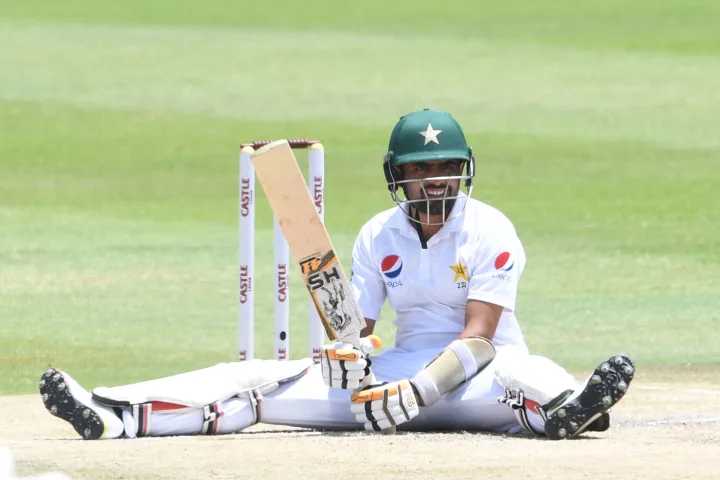Perhaps Pakistan cricket only has the emotional capacity to work on one kind of mental scarring, and it had spent most of the last generation therapising to work on that. For Pakistan, it is Australia, the country they cannot seem to buy a win in; they have lost every one of their last 17 Tests there over the best part of the last three decades, and peppered in some truly heartbreaking ICC defeats along the way for good measure.
But during the same time, they have suppressed all the trauma sustained in battle wounds against another side, one that, in away Test cricket, appears to have an equally potent stranglehold on them. Since 1995, when they first played South Africa, Pakistan have won just two Tests in the country, half of what they have managed in Australia. They have lost 12 of the other 13, nearly all of them chastening defeats: three by over 200 runs, another three by seven or more wickets, and a couple by an innings. In 2013, they were shot out at the Wanderers for 49 by prime Dale Steyn; it remains their lowest total in Test history.
And while every defeat in Australia has produced its own epic, in South Africa the losses morph into one. The bowlers have been ground into the dirt, the batters shot out in a trice. There’s the odd good session, quickly followed by two of self-destruction, a wistful what-if, and everyone moves on. The masochistic tendency to relive and agonise over every defeat – like Pakistan do against Australia – isn’t quite there. About two times a decade the same performances are rinsed and repeated, and the same losses meted out almost perfunctorily.
Mickey Arthur, who has sat in both dugouts on such tours, feels he understands exactly what happens every time, without quite knowing how to fix it.
“I think South Africa is one of the hardest places to bat in in the world,” he tells ESPNcricinfo. “[When I was] with South Africa, we knew that with Pakistan, if we could build pressure for long periods of time, we would ultimately get good results. We always felt Pakistan’s breaking point was quite low as a team. We could get in amongst them, and I wouldn’t say bully them, but we could come hard and be aggressive with the ball because ultimately they would succumb.”
It is a pattern South Africa have trapped Pakistan in every time they tour here, both with bat and ball. In the first Test the two sides played, in Johannesburg in 1995, Pakistan had South Africa under the cosh at 168 for 5 in the first innings. But a monster sixth-wicket stand between Jonty Rhodes and Brian McMillan got the hosts out of that mess, and by the time Pakistan broke it, they were mentally broken themselves. The last two wickets added a further 93 as a Pakistan side that included Wasim Akram and Aaqib Javed sent down 64 extras. Pakistan would be bowled out for exactly half of South Africa’s total, and lose by 324 runs.
Not much had changed by the most recent tour. In 2018 in Centurion, where the first Test of the current tour will be played, Pakistan had worked themselves into an exceptional position by tea on the second day; they were 101 for 1 in the third innings on a surface where fast bowlers had enjoyed complete dominance for much of the first five sessions. As soon as the second wicket fell, though, a collapse ensued; Pakistan lost their last nine for 89, and South Africa had coasted home before tea the next day.
“When I went there with Pakistan,” Arthur says, “I knew exactly what the template was. We tried to make sure our batters were in the best possible way in terms of belief, confidence and skillset in order to make that happen. And apart from one real shocking session in Centurion, it kind of worked for a period of time. The other thing with your bowlers is you’ve got to be patient. If you get gung-ho there as a bowling unit, and try to use pace and bounce too much, then you can get caught out.”
That is the other frustrating mystery for Pakistan in South Africa. Pakistan’s batting struggles in such conditions are almost a certainty to be strategised around, but in arguably the most pace-friendly conditions in the world, Pakistan’s own vaunted pace battery has largely disappointed.
Akram averaged nearly 40 there in two Tests, Aaqib just under 37. Mohammad Abbas, Umar Gul and Azhar Mahmood have each conceded between 46.20 and 47.00 runs for their wickets, while Waqar Younis and Shoaib Akhtar, two of Pakistan’s more successful seamers, managed solid but unspectacular averages of 28.30 and 29.30 respectively. Only Mohammad Asif (18.47) and Mohammad Amir (23.58) have truly excelled. Shaheen Shah Afridi, who averages a very respectable 26.66, is not part of the current Test side.
“They [Pakistan’s fast bowlers] bowl the wrong lengths,” Arthur says bluntly. “In South Africa, you get a little bit too excited when you see the ball flying through to the keeper. If you get too short, the South African batters are going to put you away. You have got to be disciplined and get enough balls in the right area. And if you do that, you can break them as a team.”
Arthur makes no effort to conceal his feelings about Afridi not being part of the Test squad. When the squads for this series were announced, he was not named for the red-ball side; he will instead be playing in the Bangladesh Premier League, suggesting this format, in which he was among the world’s best up until two years ago, may not quite take pride of place among his priorities anymore.
“I can’t believe it,” Arthur says. “If he’s not bowling in South Africa, then where the hell are they bowling him? It’s the best place to bowl in the world, almost. Plus, he gives you a left-arm option. I know they have got Mir Hamza, but Shaheen is a game-breaker and match-winner. I’m not in the inner echelon in terms of knowing the ins and outs of why they haven’t selected him, but on pure skill, I would have him in South Africa in any team I pick.”
Curiously, it is some of Pakistan’s most prominent spinners who have enjoyed bowling here. Mushtaq Ahmed masterminded Pakistan’s first win in South Africa, taking nine wickets in Durban in 1998. In their only other victory here, achieved while Mushtaq was bowling coach, it was another legspinner, Danish Kaneria, who took seven wickets in Gqeberha in 2007 as Pakistan eked out a tense win.
In the 1998 Durban Test, Mushtaq found a way for the surface to assist him. Late on the fourth day, he began to work through the South African top order as they set up in pursuit of 255. In an attack that included Waqar and Akhtar, it was Mushtaq who took on the leadership role, bowling 37 of 88.2 overs, taking six wickets as Pakistan squeezed home by 29 runs.
“The most important thing I told myself was, on the fourth and fifth days, spinners get help, regardless of where in the world you are,” Mushtaq tells ESPNcricinfo. “In fact, you get more help in South Africa and Australia than other places because on dry pitches like those, you get pace along with turn. So if a batter plays a poor shot or misreads line and length, they won’t have time to adjust. On Asian pitches, even if you deceive a batter off the pitch or in the air, the lack of pace allows them to adjust.
“Our fast bowlers are often used to reverse swing. And for reverse swing, you have to bowl full. Whereas in South Africa, you want bowlers like [Kagiso] Rabada, [Anrich] Nortje, [Glenn] McGrath who bowl into the pitch. Whoever bowls top of off, as Naseem Shah can do, will be successful there.”
For Mushtaq, however, the key is patience. “South Africa demands good overs, not good balls,” he says. “I took wickets there because I knew how to use the bounce. Shane Warne enjoyed himself in South Africa, too. Overspinners, especially legspinners who have variations, will always be successful there because the pitches help you out. You get bounce, and bounce is very useful, whether it is Tests or ODIs. Because some go straight on and others turn, and that natural variation only comes to overspinners.”
It is why, he says, Yasir Shah never quite managed to crack South Africa, Australia, or New Zealand. “In the UAE, where he got so many of his wickets, on those dry pitches you had to bowl over 90kph, because it gave you grip,” he says. “That brought lbw and bat-pads into the game. Yasir was too quick, and South African pitches demand you bowl slower, sometimes as slow as less than 80kph. For overspin, you have to reduce the speed and let it spin in the air. When it picks up those revolutions in the air, it gives you pace off the pitch naturally. When you bowl fast there, they don’t spin, you might as well be giving the batters throwdowns. And batters will never get out to that.”
This time around, though, stung by Yasir’s experience, Pakistan are unlikely to give legspinner Abrar Ahmed a run, especially not in Centurion, where the conditions, as South Africa captain Temba Bavuma said, never fail to assist the fast bowlers. But for Pakistan, seam-friendliness has not reliably translated into seam-success, which is probably the core reason for their underperformance here.
Arthur also believes Pakistan’s fast bowlers have had a tendency to fall away with the older ball at the end of long days, and let games get away from them. In 2007, when Pakistan won a Test, they had a golden opportunity to press home the advantage in Centurion, where Asif had reduced South Africa to 53 for 3, removing each of Graeme Smith, AB de Villiers and Jacques Kallis in a scintillating spell with the hosts trailing by a further 260. However, as the ball grew older and the day aged, Ashwell Prince and Herschelle Gibbs dug in; by the end of the day, South Africa were up to 254 for 4 and would ultimately seal a routine seven-wicket victory.
“That was one of the reasons we [Pakistan] worked so hard on our fitness, and on getting our bowlers mentally tough,” Arthur says. “You’re getting conditions you can work with. But the minute you fall away and your first spell is excellent, your second spell is okay, your third spell falls away, you’re going to get punished in the last session of the day. And I see so many teams being beaten by South Africa in the last session of the day. You lose a session badly, and there’s no coming back from that.”
There is the bigger picture of silverware down the line for South Africa. One win across these two games will guarantee a spot at the World Test Championship final, and though Pakistan no longer have any realistic aspirations for that crown, they can still play spoiler as India, Australia and Sri Lanka all wrestle for a berth.
For the visitors, though, victory in South Africa does not need to be transacted by context of any kind. Aside from the two Tests they have won, they have never realistically run South Africa close. It has, perversely, meant there’s less scrutiny of those heavier defeats, usually put down to a superior opposition and unfriendly conditions rather than a rethink of how to reverse that slide.
Mushtaq summed it up pithily. “When we go there [now], it takes the Pakistani team time to adjust. It can take a couple of weeks, and by that time the Tests are pretty much over.”










Leave a Reply